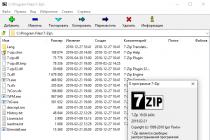Task Manager Windows 10 contains detailed tools monitoring GPU (GPU). You can view the usage of each application and the system-wide GPU, and Microsoft promises performance task manager will be more accurate than third-party utilities.
How it works
These functions GPU were added in the update Fall creators for Windows 10 also known as Windows 10 version 1709 ... If you are using Windows 7, 8 or more old version Windows 10, you won't see these tools in your task manager.
Windows uses newer features in the Windows Display Driver Model to extract information directly from GPU (VidSCH) and video memory manager (VidMm) in the WDDM graphics core, which are responsible for the actual resource allocation. It shows very accurate data no matter what API applications are using to access GPU-Microsoft DirectX, OpenGL, Vulkan, OpenCL, NVIDIA CUDA, AMD Mantle, or whatever.
That is why in task manager only systems with WDDM 2.0 compliant are displayed GPUs ... If you don't see it, your system's GPU is probably using an older type of driver.
You can check which version of WDDM your driver is using GPU by pressing Windows Key + R, typing "dxdiag" in the box and then pressing "Enter" to open the tool " DirectX Diagnostic Tool". Click the Display tab and look to the right of Model in the Drivers section. If you see the WDDM 2.x driver here, your system is compatible. If you see the WDDM 1.x driver here, your GPU not compatible.

How to view GPU performance
This information is available in task manager although it is hidden by default. To open it, open Task Manager by right-clicking on any empty spot on the taskbar and choosing " Task Manager"Or by pressing Ctrl + Shift + Esc on your keyboard.
Click the "Details" button at the bottom of the " Task Manager"If you see a standard simple view.

If GPU not showing up in task manager , v full screen mode on the tab “ Processes"Right-click any column header and then enable the" GPU ". This will add a column GPU which allows you to see the percentage of resources GPU used by each application.
You can also enable the option “ GPU core"To see which GPU the application is using.

General use GPU of all applications on your system is displayed at the top of the column GPU... Click a column GPU to sort the list and see which apps are using your GPU most of all at the moment.
Column number GPU is the highest usage the app uses across all engines. So, for example, if an application uses 50% of the GPU 3D engine and 2% of GPU video decoding, you will simply see that the GPU column displays 50%.
In the column " GPU core»Each application is displayed. This shows you which physical GPU and what engine the application is using, such as whether it uses a 3D engine or a video decoding engine. You can determine which GPU meets a certain metric by checking the “ Performance", Which we'll talk about in the next section.

How to view an app's video memory usage
If you are wondering how much video memory an application is using, you need to go to the Details tab in the Task Manager. On the Details tab, right-click any column heading and select Select Columns. Scroll down and turn on the speakers " GPU », « GPU core », « " and " ". The first two are also available in the Processes tab, but the last two memory options are only available in the Details pane.

Column " Dedicated GPU memory "Shows how much memory the application is using on your GPU... If your PC has a discrete NVIDIA or AMD graphics card, then this is part of its VRAM, that is, how much physical memory on your graphics card the application uses. If you have integrated graphics processor , some of your regular system memory is reserved exclusively for your graphics hardware. This shows how much of the reserved memory is being used by the application.
Windows also allows applications to store some data in regular system DRAM. Column " Total GPU Memory »Shows how much memory the application is currently using for video devices from the computer's regular system RAM.
You can click any of the columns to sort by them and see which application is using the most resources. For example, to view the applications that are using the most video memory on your GPU, click the “ Dedicated GPU memory ».

How to track GPU share usage
To track general statistics on resource usage GPU, go to the " Performance"And look at" GPU»At the bottom of the sidebar. If your computer has multiple GPUs, you will see multiple options here GPU.
If you have multiple GPUs linked - using a feature such as NVIDIA SLI or AMD Crossfire, you will see them identified with a "#" in their name.

Windows displays use GPU in real time. Default Task Manager tries to display the most interesting four engines according to what is happening on your system. For example, you will see different graphics depending on whether you are playing 3D games or encoding videos. However, you can click any of the names above the graphs and select any of the other available engines.
Your name GPU is also displayed in the sidebar and at the top of this window, making it easy to check what graphics hardware is installed on your PC.
You will also see graphs of the allocated and shared memory usage GPU... Shared memory usage GPU refers to how much of the total system memory is used for tasks GPU... This memory can be used for both normal system tasks and video recordings.
At the bottom of the window, you will see information such as the version number of the installed video driver, development date, and physical location GPU on your system.

If you want to view this information in a smaller window that is easier to leave on screen, double-click somewhere inside the GPU screen, or right-click anywhere inside it and select the " Graphical summary". You can maximize the window by double-clicking on the panel or by right-clicking on it and unchecking the “ Graphical summary».
You can also right-click on the graph and select Modify Graph> Single Core to view only one engine graph GPU.

To keep this window on your screen at all times, click Options> Over the rest of the windows».

Double click inside the panel GPU again, and you have a minimal window that you can position anywhere on the screen.
Got the ability to track graphics processing unit (GPU) performance data. Users can analyze this information to understand how the resources of the graphics card, which are increasingly used in computing, are used.
This means that all GPUs installed in the PC will be shown in the “Performance” tab. In addition, in the Processes tab, you can see which processes are accessing the GPU, and the GPU memory usage data is located in the Details tab.
How to check if the GPU Performance Viewer is supported
Although Task Manager does not have specific requirements for monitoring CPU, memory, disk, or network adapters, the situation with GPUs looks a little different.
In Windows 10, GPU information is only available in Task Manager when using the Windows Display Driver Model (WDDM) architecture. WDDM is an architecture graphics drivers for a graphics card that allows rendering of the desktop and applications on the screen.
WDDM provides graphics core which includes a scheduler (VidSch) and a video memory manager (VidMm). It is these modules that are responsible for making decisions when using GPU resources.
The task manager receives information about GPU resource utilization directly from the scheduler and video memory manager of the graphics core. Moreover, this is true both in the case of integrated, and in the case of dedicated graphics processors. For correct work functionality requires WDDM version 2.0 or higher.
To check if your devices support viewing GPU data in Task Manager, follow these steps:
- Use the Windows Key + R keyboard shortcut to open the Run command.
- Enter the command dxdiag.exe to open the DirectX Diagnostic Tool and press the Enter key.
- Click on the “Display” tab.
- In the right section “Drivers” look at the meaning of the driver model.
If you are using WDDM 2.0 or higher, Task Manager will display GPU usage in the Performance tab.
How to monitor GPU performance using Task Manager
To monitor GPU performance data using Task Manager, simply right-click on the taskbar and select Task Manager. If the compact view is active, click the Details button and then click the Performance tab.
Advice: for quick launch In Task Manager, you can use the keyboard shortcut Ctrl + Shift + Esc
Performance tab
If your computer supports WDDM version 2.0 or later, on the left pane of the tabs Performance your GPU will be displayed. In case there are multiple GPUs installed in the system, each of them will be shown using a number corresponding to its physical location, for example, GPU 0, GPU 1, GPU 2, etc.

Windows 10 supports bundles of multiple GPUs using Nvidia SLI and AMD Crossfire modes. When one of these configurations is found on the system, the Performance tab will indicate each link using a number (eg Link 0, Link 1, etc.). The user will be able to see and check every GPU within the bundle.
On a specific GPU page, you will find a summary of performance data, which is generally divided into two sections.
This section contains current information about the engines of the GPU itself, and not about its individual cores.
The Task Manager displays the four most requested GPU engines by default, which include 3D, copying, video decoding, and video processing by default, but you can change these views by clicking on the name and choosing a different engine.

The user can even change the view of the chart to one slider by right-clicking anywhere in the section and choosing the "Change Chart> Single Core" option.

Below the graphs of the engines is a data block on video memory consumption.
The Task Manager shows two types of video memory: shared and dedicated.
Dedicated memory is memory that will only be used by the graphics card. This is usually the amount of VRAM on discrete cards or the amount of memory available to the processor on which the computer is configured to explicitly reserve.

In the lower right corner, the Hardware Reserved Memory option is displayed - this amount of memory is reserved for the video driver.
The allocated memory in this section represents the amount of memory actively used by processes, and the total memory in this section represents the amount of system memory consumed for graphics purposes.
In addition, in the left pane under the name of GPUs, you will see the current percentage of GPU utilization. It is important to note that Task Manager uses the percentage of the busiest engine to represent overall usage.

To see performance data over time, run a GPU-intensive application, such as a video game.
Processes tab
You can also monitor GPU performance in the tab Processes... In this section, you will find a high-level summary for a specific process.
The GPU column shows the use of the most active engine to represent the total use of GPU resources by a particular process.

However, confusion can arise if multiple engines report 100 percent utilization. An additional column “GPU core” provides detailed information about the engine loaded by this process.
The column heading on the Processes tab shows the total resource consumption of all GPUs available on the system.

If you do not see these columns, right-click on the header of any column and check the appropriate boxes.
Details tab
By default, the tab does not display GPU information, but you can always right-click on a column header, select the Select Columns option, and enable the following options:
- GPU core
- Dedicated GPU memory
- Total GPU Memory
Memory tabs display the total and allocated amounts of memory, respectively, that are used by a particular process. The GPU and GPU Core columns show the same information as in the Processes tab.
When using the Details tab, you need to be aware that the addition of used memory by each process may be larger than the total available memory, since the total memory will be counted several times. This information is useful for understanding memory usage in a process, but you should use the Performance tab to see more accurate information on graphics usage.
Output
Microsoft is committed to providing users with a more accurate tool for assessing the performance of the graphics subsystem compared to third party applications... Note that work on this functionality is ongoing and improvements are possible in the near future.
Processors and GPUs are very similar, they are both made of hundreds of millions of transistors and can handle thousands of operations per second. But how exactly are these two important components of any home computer different?
In this article we will try to tell you in a very simple and accessible way what is the difference between a CPU and a GPU. But first, you need to consider these two processors separately.
The CPU (Central Processing Unit) is often called the "brain" of the computer. Inside the central processor, there are about a million transistors, with the help of which various calculations are performed. Home computers typically have processors that have 1 to 4 cores and are clocked at approximately 1 GHz to 4 GHz.
The processor is powerful because it can do anything. A computer is capable of performing a task because the processor is capable of performing that task. Programmers have achieved this thanks to the wide instruction sets and huge lists of functions shared across modern CPUs.
What is GPU?

A GPU (Graphics Processing Unit) is a specialized type of microprocessor optimized for very specific computing and displaying graphics. A GPU runs at a lower clock speed than a CPU, but has many more processing cores.
You can also say that a GPU is a specialized CPU made for one specific purpose - video rendering. During rendering, the GPU performs simple math calculations over and over again. A GPU has thousands of cores that will run concurrently. Although each GPU core is slower than a CPU core, it is still more efficient for performing the simple math required to display graphics. This massive parallelism is what makes the GPU capable of rendering the complex 3D graphics required by modern games.
Difference between CPU and GPU

The GPU can only perform a fraction of the operations that the CPU can, but it does so at incredible speed. The GPU will use hundreds of cores to perform urgent computations for thousands of pixels while displaying complex 3D graphics. But to achieve high speeds The GPU must perform repetitive operations.
Take the Nvidia GTX 1080 for example. This card has 2560 shader cores. Thanks to these cores, the Nvidia GTX 1080 can execute 2560 instructions or operations in one clock cycle. If you want to make the picture 1% brighter, then the GPU can handle it without much difficulty. Here comes the quad-core CPU Intel Core The i5 will only be able to execute 4 instructions per clock cycle.
However, CPUs are more flexible than GPUs. Central processing units have a larger instruction set, so they can perform a wider range of functions. Also CPUs run at higher maximum clock frequencies and have the ability to control the input and output of computer components. For example, the central processing unit can integrate with virtual memory, which is necessary to launch a modern operating system... This is exactly what the GPU cannot do.
GPU Computing
Even though GPUs are designed for rendering, they can do more. Graphics processing is just a kind of repetitive parallel computation. Other tasks like Bitcoin mining and password cracking rely on the same kinds of massive datasets and simple math calculations. This is why some users use video cards for non-graphics operations. This phenomenon is called GPU Computation or GPU Computing.
conclusions
In this article, we have compared CPU and GPU. I think it became clear to everyone that GPU and CPU have similar goals, but are optimized for different computations. Write your opinion in the comments, I will try to answer.
Many have seen the abbreviation GPU, but not everyone knows what it is. it component which is part of video cards... It is sometimes called a video card, but this is not correct. The GPU is engaged processing commands that form a three-dimensional image. This is the main element, on the power of which depends speed the entire video system.
There is several types such chips - discrete and built-in... Of course, it's worth mentioning right away that the first one is better. It is placed in separate modules. It is powerful and requires good cooling... The second is installed on almost all computers. It is built into the CPU, making the power consumption significantly lower. Of course, it cannot compare with full-fledged discrete chips, but at the moment it shows quite good results.
How the processor works
 GPU is engaged processing 2D and 3D graphics. Thanks to the GPU, the CPU of the computer becomes freer and can perform more important tasks. main feature the GPU is that it tries as much as possible increase speed calculation of graphic information. The chip architecture allows more efficiency to process graphic information than the central CPU of the PC.
GPU is engaged processing 2D and 3D graphics. Thanks to the GPU, the CPU of the computer becomes freer and can perform more important tasks. main feature the GPU is that it tries as much as possible increase speed calculation of graphic information. The chip architecture allows more efficiency to process graphic information than the central CPU of the PC.
GPU sets location three-dimensional models in the frame. Is engaged in filtration the triangles included in them, determines which ones are in sight, and cuts off those that are hidden by other objects.
We all know that a video card and a processor have slightly different tasks, but do you know how they differ from each other in the internal structure? As a CPU (eng. - central processing unit) and GPU (eng. - graphics processing unit) are processors and have a lot in common, but they were designed to perform different tasks. You will learn more about this in this article.
Cpu
The main task of the CPU, if we talk in simple words, this is the execution of a chain of instructions in the shortest possible time. The CPU is designed in such a way as to execute several such chains at the same time, or split one stream of instructions into several and, after executing them separately, merge them back into one, in the correct order. Each instruction in a thread depends on the ones following it, which is why there are so few execution units in the CPU, and all the emphasis is on execution speed and reducing downtime, which is achieved using the cache memory and the pipeline.
GPU
The main function of the GPU is to render 3D graphics and visual effects, therefore, everything is a little simpler in it: it needs to get polygons at the input, and after carrying out the necessary mathematical and logical operations, output the coordinates of the pixels. In fact, the work of a GPU boils down to operating on a huge number of independent tasks, therefore, it contains a large amount of memory, but not as fast as in a CPU, and a huge number of execution units: in modern GPUs there are 2048 or more, at that time like a CPU, their number can reach 48, but most often their number lies in the range of 2-8.
The main differences
The CPU differs from the GPU primarily in the way it accesses memory. In the GPU, it is connected and easily predictable - if a texel of a texture is read from memory, then after a while there will be a turn of neighboring texels. The situation is similar with recording - a pixel is written to the framebuffer, and after a few clock cycles, the one located next to it will be recorded. Also, the GPU, unlike the general-purpose processors, simply does not need a cache memory. big size, and textures require only 128–256 kilobytes. In addition, faster memory is used on video cards, and as a result, the GPU is available at times more bandwidth, which is also very important for parallel calculations operating with huge data streams.
There are many differences in multithreading support: CPU executes 1 – 2 computation threads per processor core, and the GPU can support several thousand threads per multiprocessor, of which there are several in the chip! And if switching from one thread to another for the CPU costs hundreds of clock cycles, then the GPU switches several threads in one clock cycle.
In the CPU, most of the chip area is occupied by instruction buffers, hardware branch prediction and huge amounts of cache memory, while in the GPU, most of the area is occupied by execution units. The above device is schematically shown below:
Computation speed difference
If the CPU is a kind of "boss" who makes decisions in accordance with the instructions of the program, then the GPU is a "worker" who performs a huge amount of the same type of calculations. It turns out that if you submit independent elementary mathematical problems to the GPU, then it will cope much faster than the central processor. This distinction is successfully used by bitcoin miners.
Bitcoin mining
The essence of mining is that computers located in different parts of the Earth solve mathematical problems, as a result of which bitcoins are created. All bitcoin transfers along the chain are transferred to miners, whose job is to select from millions of combinations a single hash that matches all new transactions and a secret key, which will ensure the miner receives a reward of 25 bitcoins at a time. Since the computation speed directly depends on the number of execution units, it turns out that GPUs are much better suited for performing of this type tasks rather than CPU. The greater the number of calculations performed, the higher the chance of getting bitcoins. It even came down to the construction of entire farms from video cards.













